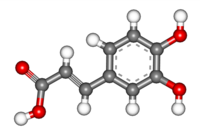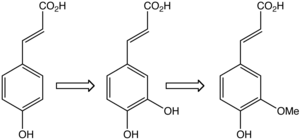Caffeic acid

| |

| |

| |
| Names | |
|---|---|
| IUPAC names
3-(3,4-Dihydroxyphenyl 2-propenoic acid
3,4-Dihydroxy-cinnamic acid trans-Caffeate 3,4-Dihydroxy-trans-cinnamate) (E)-3-(3,4-dihydroxyphenyl)-2-propenoic acid 3,4-Dihydroxybenzeneacrylicacid 3-(3,4-Dihydroxyphenyl)-2-propenoic acid | |
| Identifiers | |
3D model (JSmol)
|
|
| ChEBI | |
| ChEMBL | |
| ChemSpider | |
| DrugBank | |
| ECHA InfoCard | 100.005.784 |
| KEGG | |
PubChem CID
|
|
| UNII | |
CompTox Dashboard (EPA)
|
|
| |
| |
| Properties | |
| C9H8O4 | |
| Molar mass | 180.16 g/mol |
| Density | 1.478 g/cm³ |
| Melting point | 223–225 °C |
| UV-vis (λmax) | 327 nm and a shoulder at c. 295 nm in acidified methanol[1] |
| Hazards | |
| NFPA 704 (fire diamond) | |
| Related compounds | |
Except where otherwise noted, data are given for materials in their standard state (at 25 °C [77 °F], 100 kPa).
| |
Caffeic acid is an organic compound that is classified as hydroxycinnamic acid. This yellow solid consists of both phenolic and acrylic functional groups. It is found in all plants because it is a key intermediate in the biosynthesis of lignin, one of the principal sources of biomass.[2]
Occurrence and biological function
Caffeic acid can be found in the bark of Eucalyptus globulus.[3] It can also be found in the freshwater fern Salvinia molesta[4] or in the mushroom Phellinus linteus.[5]
Occurrences in food
Caffeic acid is one of the main natural phenols in argan oil.[6]
Metabolism
Biosynthesis
Caffeic acid, which is unrelated to caffeine, is biosynthesized by hydroxylation of coumaroyl ester of quinic ester. This hydroxylation produces the caffeic acid ester of shikimic acid, which converts to chlorogenic acid. It is the precursor to ferulic acid, coniferyl alcohol, and sinapyl alcohol, all of which are significant building blocks in lignin.[2] The transformation to ferulic acid is catalyzed by the enzyme caffeic acid-O-methyltransferase.
Caffeic acid and its derivative caffeic acid phenethyl ester (CAPE) are produced in many kinds of plants.[7][8][9]

In plants, caffeic acid (middle) is formed from 4-hydroxycinnamic acid (left) and is transformed to ferulic acid.
Dihydroxyphenylalanine ammonia-lyase is an enzyme that uses 3,4-dihydroxy-L-phenylalanine (L-DOPA) to produce trans-caffeate and NH3.
Biotransformation
Caffeate O-methyltransferase is an enzyme responsible for the transformation of caffeic acid into ferulic acid.
Biodegradation
Caffeate 3,4-dioxygenase is an enzyme that uses caffeic acid and oxygen to produce 3-(2-carboxyethenyl)-cis,cis-muconate.
Glysosides
3-O-caffeoylshikimic acid (dactylifric acid) and its isomers, are enzymic browning substrates found in dates (Phoenix dactylifera fruits).[10]
Pharmacology
Caffeic acid has a variety of potential pharmacological effects in in vitro studies and in animal models, but no clinical effects have been demonstrated in humans.
Caffeic acid is an antioxidant in vitro and also in vivo.[9] Caffeic acid also shows immunomodulatory and antiinflammtory activity. Caffeic acid outperformed the other antioxidants, reducing aflatoxin production by more than 95 percent. The studies are the first to show that oxidative stress that would otherwise trigger or enhance Aspergillus flavus aflatoxin production can be stymied by caffeic acid. This opens the door to using natural fungicide methods by supplementing trees with antioxidants.[11]
Studies of the carcinogenicity of caffeic acid have mixed results. Some studies have shown that it inhibits carcinogenesis, and other experiments show carcinogenic effects.[12] Oral administration of high doses of caffeic acid in rats has caused stomach papillomas. [12] In the same study, high doses of combined antioxidants, including caffeic acid, showed a significant decrease in growth of colon tumors in those same rats. No significant effect was noted otherwise. Caffeic acid is listed under some Hazard Data sheets as a potential carcinogen,[13] as has been listed by the International Agency for Research on Cancer as a Group 2B carcinogen ("possibly carcinogenic to humans").[14] More recent data show that bacteria in the rats' guts may alter the formation of metabolites of caffeic acid.[15][16] There have been no known ill-effects of caffeic acid in humans.
Other uses
Caffeic acid may be the active ingredient in caffenol, a do-it-yourself black-and-white photographic developer made from instant coffee.[17] The developing chemistry is similar to that of catechol or pyrogallol.[18]
It is also used as a matrix in MALDI mass spectrometry analyses.[19]
References
- ^ Kevin S. Gould, Kenneth R. Markham, Richard H. Smith and Jessica J. Goris, (2000). "Functional role of anthocyanins in the leaves of Quintinia serrata A. Cunn". Journal of Experimental Botany. 51 (347): 1107–1115. doi:10.1093/jexbot/51.347.1107. PMID 10948238.
{{cite journal}}: CS1 maint: extra punctuation (link) CS1 maint: multiple names: authors list (link) - ^ a b Boerjan, Wout; Ralph, John; Baucher, Marie (2003). "Ligninbiosynthesis". Annual Review of Plant Biology. 54: 519–46. doi:10.1146/annurev.arplant.54.031902.134938. PMID 14503002..
- ^ Santos, Sónia A. O.; Freire, Carmen S. R.; Domingues, M. Rosário M.; Silvestre, Armando J. D.; Neto, Carlos Pascoal (2011). "Characterization of Phenolic Components in Polar Extracts of Eucalyptus globulus Labill. Bark by High-Performance Liquid Chromatography–Mass Spectrometry". Journal of Agricultural and Food Chemistry. 59 (17): 9386–93. doi:10.1021/jf201801q. PMID 21761864.
- ^ Choudhary, M. Iqbal; Naheed, Nadra; Abbaskhan, Ahmed; Musharraf, Syed Ghulam; Siddiqui, Hina; Atta-Ur-Rahman (2008). "Phenolic and other constituents of fresh water fern Salvinia molesta". Phytochemistry. 69 (4): 1018–23. doi:10.1016/j.phytochem.2007.10.028. PMID 18177906.
- ^ Lee YS; Kang YH; Jung JY; et al. (2008). "Protein glycation inhibitors from the fruiting body of Phellinus linteus". Biological & Pharmaceutical Bulletin. 31 (10): 1968–72. doi:10.1248/bpb.31.1968. PMID 18827365.
{{cite journal}}: Unknown parameter|author-separator=ignored (help); Unknown parameter|month=ignored (help) - ^ ., Z. Charrouf; ., D. Guillaume (2007). "Phenols and Polyphenols from Argania spinosa". American Journal of Food Technology. 2 (7): 679. doi:10.3923/ajft.2007.679.683.
{{cite journal}}:|last1=has numeric name (help) - ^ Red Clover Flowers Herbal Information
- ^ "Dr. Duke's Phytochemical and Ethnobotanical Databases".
- ^ a b Olthof MR, Hollman PC, Katan MB (2001). "Chlorogenic acid and caffeic acid are absorbed in humans". J. Nutr. 131 (1): 66–71. PMID 11208940.
{{cite journal}}: Unknown parameter|month=ignored (help)CS1 maint: multiple names: authors list (link) - ^ 3-O-caffeoylshikimic acid (dactylifric acid) and its isomers, a new class of enzymic browning substrates. V.P. Maier, D.M. Metzler and A. F. Huber, Biochemical and Biophysical Research Communication, 1964, 14(2), pages 124-128, PMID 5836492
- ^ "Nuts'New Aflatoxin Fighter: Caffeic Acid?".
- ^ a b M Hirose, Y Takesada, H Tanaka, S Tamano, T Kato and T Shirai (1998). "Carcinogenicity of antioxidants BHA, caffeic acid, sesamol, 4- methoxyphenol and catechol at low doses, either alone or in combination, and modulation of their effects in a rat medium-term multi-organ carcinogenesis model" (PDF). Carcinogenesis. 19 (1): 207–212. doi:10.1093/carcin/19.1.207. PMID 9472713.
{{cite journal}}: CS1 maint: multiple names: authors list (link) - ^ "Caffeic Acid (IARC Summary & Evaluation, Volume 56, 1993)".
- ^ Agents Classified by the IARC Monographs, International Agency for Research on Cancer
- ^ MA Peppercorn and P Goldman (1972). "Caffeic acid metabolism by gnotobiotic rats and their intestinal bacteria". Proceedings of the National Academy of Sciences. 69 (6): 1413–1415. doi:10.1073/pnas.69.6.1413. PMC 426714. PMID 4504351.
- ^ M-P Gonthier, M-A Verny, C Besson, C Rémésy and A Scalbert (1 June 2003). "Chlorogenic acid bioavailability largely depends on its metabolism by the gut microflora in rats". Journal of Nutrition. 133 (6): 1853–1859. PMID 12771329.
{{cite journal}}: CS1 maint: multiple names: authors list (link) - ^ Caffenol blog "Caffenol-C-M, recipe"
- ^ Williams, Scott "A Use for that Last Cup of Coffee: Film and Paper Development", Technical Photographic Chemistry 1995 Class, Imaging and Photographic Technology Department, School of Photographic Arts and Sciences Rochester Institute of Technology
- ^ Beavis RC, Chait BT (1989). "Cinnamic acid derivatives as matrices for ultraviolet laser desorption mass spectrometry of proteins". Rapid Commun. Mass Spectrom. 3 (12): 432–5. doi:10.1002/rcm.1290031207. PMID 2520223.
{{cite journal}}: Unknown parameter|month=ignored (help)
External links
- "Chemical Land". Caffeic Acid as Carbocyclic Carboxylic Acid.


